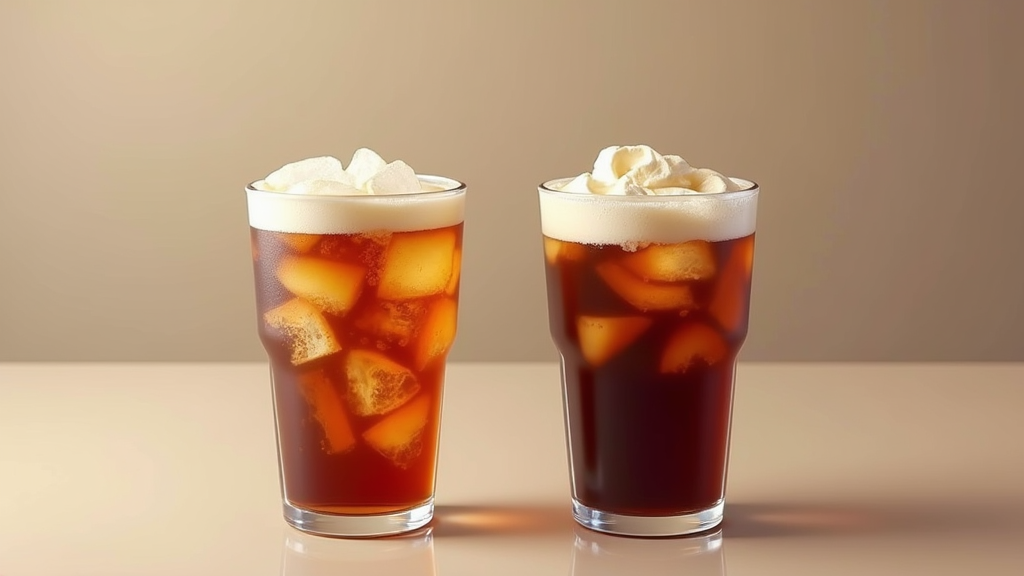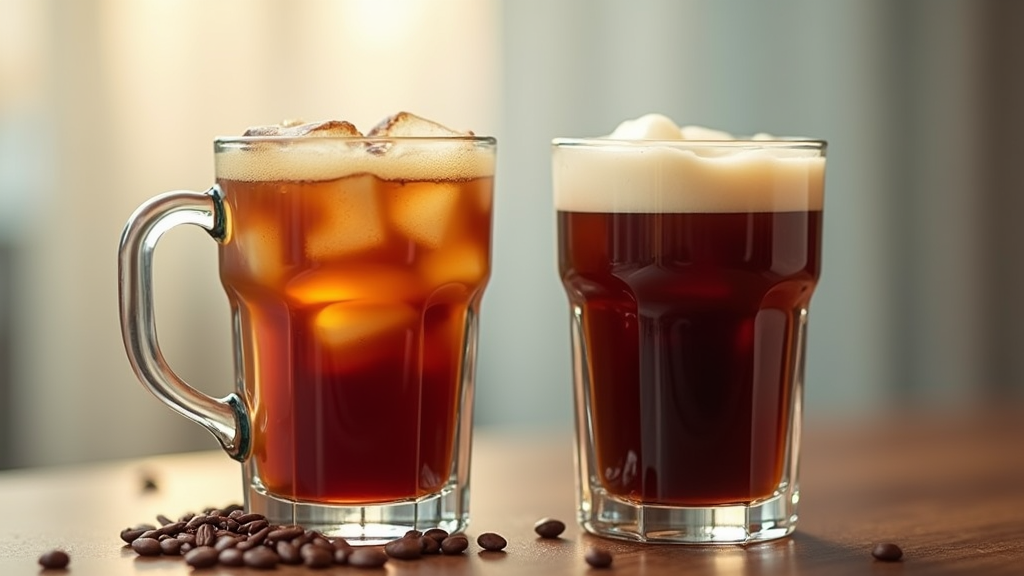Table of Contents
- Exploring What’s the Difference Between Cold Brew and Regular Coffee
- Exploring the Difference Between Cold Brew and Regular Coffee
- Detailed Guide: Cold Brew and Regular Coffee Differences
- Brewing Methods: Contrasting Cold Brew and Regular Coffee
- Flavor Profiles: Comparing Cold Brew and Regular Coffee
- Caffeine Content: Cold Brew vs. Regular Coffee Analysis
- Acidity Levels: Cold Brew vs. Regular Coffee Explained
- Preparation: Essential Steps for Cold Brew and Regular Coffee
- Step-by-Step Process: Brewing Cold Brew and Regular Coffee
- Advanced Techniques: Enhancing Cold Brew and Regular Coffee
Exploring What’s the Difference Between Cold Brew and Regular Coffee

Why Knowing Cold Brew vs Regular Coffee Matters
Coffee is more than just a morning pick-me-up; it’s a ritual, an experience, and for many, a passion. With countless brewing methods and coffee types available, navigating the world of coffee can be both exciting and overwhelming. Two popular contenders, cold brew and regular coffee, often spark curiosity. Understanding the nuances between them isn’t just about knowing what you’re drinking; it’s about enhancing your coffee experience and tailoring it to your specific preferences. The rise of cold brew, with its smoother taste and lower acidity, has captured the attention of coffee aficionados and casual drinkers alike.
Knowing what sets cold brew apart from its traditionally brewed counterpart allows you to make informed choices, whether you’re selecting a drink at your local café or experimenting with home brewing. This knowledge empowers you to appreciate the unique qualities of each brew and discover which one best suits your taste and lifestyle. The cold brew market has seen substantial growth, with annual increases of 10-15% in recent years, reflecting a shift in consumer preferences and a growing interest in this distinct brewing method.
Regular Coffee and Cold Brew Historical Background
Regular coffee, typically brewed hot, boasts a rich history that spans centuries, becoming a staple in households and coffee shops worldwide. Its brewing methods have evolved over time, from simple stovetop pots to sophisticated espresso machines. In contrast, cold brew is a relatively recent phenomenon, gaining significant traction in the last decade.
While the concept of cold brewing has existed for longer, its commercial popularity is new. The appeal of cold brew lies in its smoother, less acidic profile, making it a refreshing alternative to traditional hot coffee, especially during warmer months. The cold brew market growth is impressive, with an annual increase of 10-15% in recent years, signaling a significant shift in consumer preferences and highlighting the beverage’s increasing appeal.
Learning Core Cold Brew vs Regular Coffee Concepts
This guide will delve into the core concepts that differentiate cold brew from regular coffee, focusing on key aspects such as brewing methods, flavor profiles, caffeine levels, and acidity. By understanding these elements, you’ll gain a comprehensive understanding of what makes each brew unique.
Beyond theoretical knowledge, this guide aims to provide practical applications, enabling you to choose the right coffee based on your taste preferences and offering tips for home brewing. Whether you’re a seasoned coffee connoisseur or a curious beginner, this information will equip you with the knowledge to make informed decisions and elevate your coffee experience.
Exploring the Difference Between Cold Brew and Regular Coffee
Cold Brew vs. Regular Coffee: Fundamental Concepts
The world of coffee offers a diverse range of brewing methods, each yielding unique flavors and experiences. Two popular choices are cold brew and regular coffee (typically hot brewed). Understanding the core difference between cold brew and regular coffee hinges on the extraction method. Cold brew involves steeping coarsely ground coffee in cold or room-temperature water for an extended period, typically 12-24 hours. Regular coffee, on the other hand, uses hot water to quickly extract flavors from coffee grounds.
This difference in temperature significantly impacts the flavor profile. The extended cold brew process results in a smoother, less acidic coffee concentrate. Hot brewing extracts more oils and acids, leading to a brighter, more intense flavor.
Essential Components for Cold Brew and Regular Coffee
Both brewing methods require specific components to achieve optimal results. For cold brew, the essentials include:
- Coarsely ground coffee beans, often a medium-dark roast for a richer flavor.
- Cold or room-temperature water.
- A container for steeping, such as a jar or pitcher.
- A filter, which can be a fine-mesh sieve, cheesecloth, or a coffee filter, to separate the grounds from the concentrate.
Regular coffee brewing requires:
- Coffee beans, with a wide variety of roasts and origins to choose from.
- Hot water, ideally between 195-205°F (90-96°C) for optimal extraction.
- Brewing equipment, such as a drip machine, French press, pour-over device, or espresso machine, depending on the desired brewing style.
Detailed Guide: Cold Brew and Regular Coffee Differences

Brewing Methods: Contrasting Cold Brew and Regular Coffee
The primary difference between cold brew and regular coffee lies in their brewing methods. Cold brew involves steeping coarsely ground coffee in cold water for an extended period, typically 12-24 hours. This process results in a smoother, less acidic taste. A common coffee-to-water ratio is 1:4 or 1:5. Regular coffee, on the other hand, is brewed with hot water using methods like drip, French press, or espresso, which enhances acidity and brings out complex flavors. The ideal water temperature for regular coffee is between 195-205°F (90-96°C), with a brewing time of 5-7 minutes, depending on the method.
Flavor Profiles: Comparing Cold Brew and Regular Coffee
Cold brew is known for its smooth, sweet, and naturally low-acidic flavor profile. Common flavor notes include chocolate, nutty, and caramel undertones. In contrast, regular coffee often features brighter, more complex flavors with a more pronounced acidity. The flavor notes in regular coffee can vary widely depending on the bean origin and roast level, ranging from citrusy and floral to earthy.
Caffeine Content: Cold Brew vs. Regular Coffee Analysis
Cold brew generally boasts a higher caffeine concentration compared to regular coffee, primarily due to its higher coffee-to-water ratio. A 12-ounce (355 ml) serving of cold brew can contain between 200-300 mg of caffeine. Regular coffee typically contains less caffeine, with a 12-ounce (355 ml) serving averaging between 100-150 mg.
Acidity Levels: Cold Brew vs. Regular Coffee Explained
One of the significant differences is the acidity level. Cold brew exhibits low acidity because the cold brewing process extracts fewer acidic compounds, making it gentler on the stomach. The pH level of cold brew typically ranges from 5.0 to 6.0. Regular coffee has a higher acidity because hot brewing methods extract more acidic compounds, resulting in a brighter flavor. The pH level of regular coffee typically falls between 4.5 and 5.5.
Preparation: Essential Steps for Cold Brew and Regular Coffee
Preparing cold brew requires coarsely ground coffee, cold water, a jar or pitcher, and a strainer or filter. The initial setup involves grinding the coffee coarsely and using a ratio of 1:4 or 1:5 coffee to water. Using filtered water and ensuring proper steeping time are crucial for the best taste. Regular coffee preparation requires coffee beans, hot water, and brewing equipment such as a drip machine or French press. The initial setup involves grinding the coffee according to the brewing method and heating the water to 195-205°F. Water temperature significantly affects extraction, and grind size matters.
Step-by-Step Process: Brewing Cold Brew and Regular Coffee
To make cold brew, combine coffee grounds with cold water in a jar or pitcher, steep for 12-24 hours in the refrigerator or at room temperature, and strain through a fine mesh or coffee filter. Serve over ice and dilute with water or milk to taste. For regular coffee using the drip method, place a coffee filter in the drip machine, add ground coffee to the filter, pour hot water into the machine’s reservoir, allow the coffee to brew and drip into the carafe, and serve hot.
Advanced Techniques: Enhancing Cold Brew and Regular Coffee
For cold brew, experiment with different beans to personalize your coffee experience and adjust brewing ratios and methods to cater to a wide range of tastes and preferences. Consider trying nitro cold brew by infusing it with nitrogen for a creamy texture. For regular coffee, adjust the grind size for different brewing methods (e.g., coarse for French press, fine for espresso). Pre-wetting (blooming) the grounds for 30 seconds before brewing can enhance flavor. Maintaining a consistent water temperature is crucial for optimal extraction.

